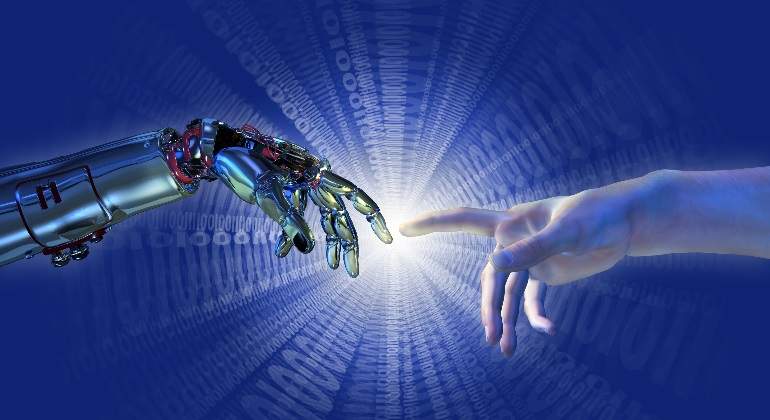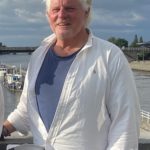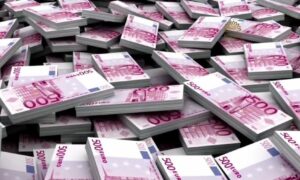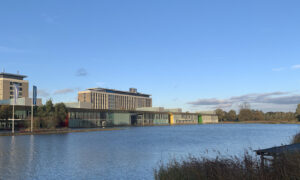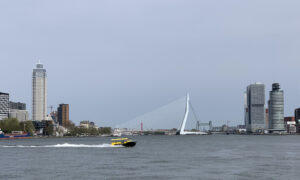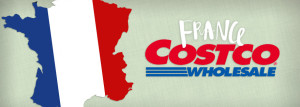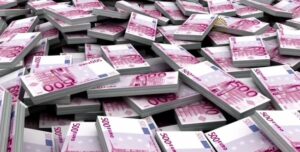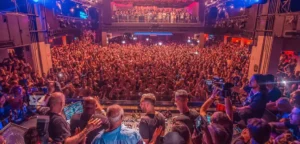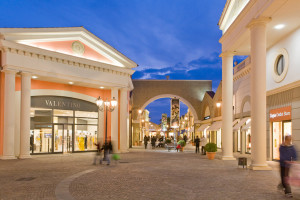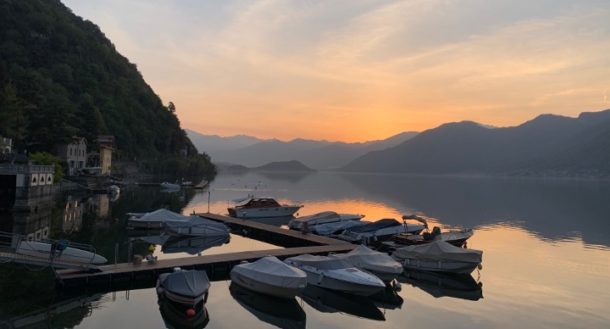(Editor’s note: We started the Eindhoven Business Briefing in 2017, because we had more news in our headquarters city – which has a huge expat population – than we could possibly post. The future really is being invented here. Send your news to: [email protected])
So, what’s the next big thing?
We’re glad you asked. We just got back from KPN’s The Next Big Thing ideation session, so we know the answer. (Hint: Think bending spoons with your mind.)
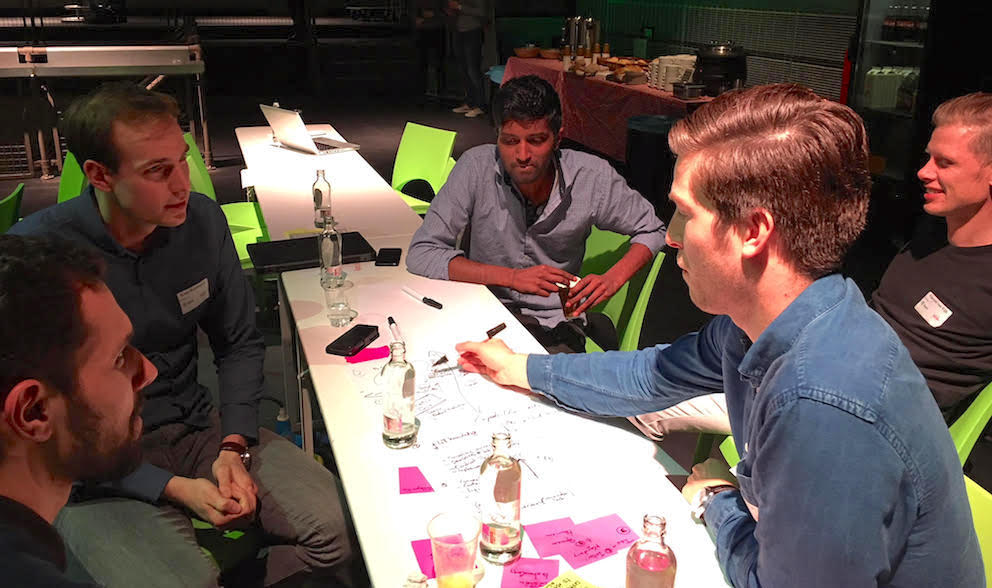
TEAM ONE WANTED TO BLUR THE LINE BETWEEN TECH AND HUMANS. FROM LEFT, KOEN ROZENDAAAL, NITHORSAN NADARAJAH, DAAN VAN DIJK AND VINCENT VAN EIJK.
In collaboration with the Eindhoven-based HighTechXL accelerator, communications giant KPN sponsored the event at Eindhoven’s Effenaar events complex, with about 200 people divided into 20 teams.
And we can reveal the next big thing is using brain control to make life better for aging populations.
KPN trainee Arco Ottenhof made Team 19’s winning pitch for KPN to develop futuristic technology that would allow seniors to convert brain power into kinetic energy to complete the physical tasks aging bodies struggle to do.
“What if you have a watch with sensors that can detect brain waves?” Ottenhof said in his 1-minute pitch on stage. Such a tech link would make life easier, enabling the elderly to open doors or call nurses, he said. “You could start your coffee machine.”
Team 19 sees two opportunities for KPN:
1 – Collecting health data and giving tailored healthcare advice
2 – Using networks for the brainwave technology.
That was just one of 20 pitches from teams that ranged from experienced entrepreneurs to young talent already in KPN’s aggressive effort to spot and fund startups.
The event started with a clean-sheet, no limits ideation session, with teams given minimal direction: “What’s the future going to bring, and what will KPN’s role be?”
There were two winning teams: one chosen by the crowd and one by the HighTechXL and KPN jury. The crowd voted for Team 9, whose pitch addressed food shortage by AI-enabled blockchain technology. The jury decided Ottenhof’s pitch for Team 19’s brainwave sensor concept to assist the elderly was not only innovative but got top scores for positive impact and the potential for further development.
The 24-year-old Otterho, from Amersfoort, is on a 6-month assignment with KPN. After working in big data analysis, he’s now focusing on project management.
Marie-José van den Boomgaard, startup liaison manager for KPN New Business, said KPN and HighTechXL executives will discuss turning the brainwave concept into a pilot.
One of the common themes was integrating technology and human/computer interface to create an advanced hybrid.
Which was Team One’s approach as pitched by Koen Rozendaal:
What we suggest is, we leverage currently available technology … and future technology to actually transcend from physical human beings to digital-conscious entities toward a ‘Matrix’ kind of environment.
“We wanted to go with the most extreme stuff,” said his teammate Vincent van Eijk, incorporating ideas from The Matrix movie with existing technology.
The day started with HighTechXL founder Guus Frericks talking about the challenge from China.
“We talk about Amazon, Facebook. But in China, you have these companies as well, and they’re expanding … at a tremendous speed. I’m kind of worried about that,” Frericks said. “I’m optimistic. I’m an optimist by nature. But I also believe we need to continuously raise the bar to stay ahead of the game.”
In China, kids in primary school are taught coding and hardware skills, said Frericks, who’d just returned from HighTechXL’s operations in Shanghai. “We need to stay ahead of the game,” and the way to stay ahead is to have open innovation, he said.
Jasper Snijder, KPN’s executive VP of New Business, said to stay competitive, his company went from being a conventional telecom with shrinking revenue to a digital company constantly on the prowl for interesting startups and innovative ideas.
KPN New Business is a separate department. A 60-person Innovation team is charged with scouting new innovations as well as matching startups with KPN, in forms of co-creation, pilots, distribution investments or being a supplier for startups and scale-ups.
The KPN model is to find promising startups, incubate them, then scale them up on the way to turning them into stand-alone companies.
For 2017, the eight people on the KPN New Business Liaison Team:
• closed 81 deals with startups in 33 different industry segments including IoT and digital health.
• visited 10 startup events each month
• have more than 1,150 startups in their database
KPN New Business teams total 420 people.
There’s also a separate KPN Ventures team under its CFO with 70 million euros in capital to deploy. Investments range from 500,000 euros to 1.5 million euros for a minority stake on the way to an exit, not acquisition. Investment areas include IoT, OTT and mobile, digital healthcare, cybersecurity, cloud and data & analytics.
https://youtu.be/xaHR32sRnUQ
ASML HIRING 3,000 PEOPLE
If you want to understand why we focus so much energy on Eindhoven, you need to go to ASML, which is the semiconductor giant that makes machines that make the digital age possible.
This Philips semiconductor-industry spinoff, which has an 85 share in the photolithography industry, is hiring 3,000 people at the rate of about 250 new employees per month, according to ASML employees. Many of these new hires are highly skilled migrants, so ASML is likely the biggest employer of Eindhoven’s burgeoning expat community.
(City officials estimate Eindhoven must add 30,000 housing units in the next 10 years.)
ASML is a multinational company with offices in 60 cities in 16 countries. The company has somewhere north of 20,000 employees, with a top-line 2017 revenue of 9 billion euros.
We were at ASML for the HighTechXL Impact Finals on 12 March. The event was held in the new cafeteria atrium which is just down the hall from the company’s in-house museum.
The ASML Experience Center has a nondescript entrance that you don’t really notice because the walls outside are covered with tiles representing the company’s 13,000 patents. ASLM’s 50 million euro-plus units are shipped around the world along with a 6-person crew to assemble them and get them running.
We were invited to tour the Experience Center, but weren’t allowed to take photos or even notes outside of the HighTechXL event. So we ‘re going by memory. Let’s just say the technology made a lasting impression. This is the company where physicists and engineers really do validate Moore’s Law, making room-size machines that make it possible to make chips twice as powerful and half as expensive about every 18 months.
The basis of ASLM technology is photolithography, the process of using light to etch microcircuitry onto silicon chips. ASML introduced Extreme Ultraviolet lithography into volume chip production last year … one of the milestone technology transitions for the semiconductor industry.
The campus in the Veldhoven section of Eindhoven is huge, and there’s actual production there. But what we see here is just the heart of the company. If you get a chance to take the ASML Experience Center tour, do it and you’ll come away stunned at how quickly technology really is advancing in the 21st century.
Quick hits:
It’s not enough that Eindhoven is a tech center. It’s also a design center. Now, Architectural Digest has a big story, “The Eindhoven Effect,” about Eindhoven’s influence on the design world.
The center of Dutch design is Design Academy Eindhoven in the middle of the city.
Eindhoven, like Rotterdam in fashion, revolutionized the design world in the 1990s with a generation of talent that’s still incredibly influential.
From that post:
Since it was established in 1947, the school has employed gifted designers in their own right to mold minds from near and far, producing some of the world’s top creative talents—most notably, a group of irreverent designers of the 1990s and early aughts, that came to define the meaning of the phrase “Dutch Design”: Studio Job, Hella Jongerius, Maarten Baas, Piet Hein Eek. But nearly 20 years later, a new generation is up to bat, and Eindhoven, where they all studied, feels once again like the place it all started.
The post profiles several designers, some of whom are expats.
We live here, so we know Eindhoven is more than a “small manufacturing city,” as AD terms it. It’s an innovation center where creativity is the norm.
Co-CEO of Dispatches Europe. A former military reporter, I'm a serial expat who has lived in France, Turkey, Germany and the Netherlands.


